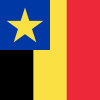Camille Coquilhat
| Camille-Aimé Coquilhat | |
|---|---|
.jpg) Portrait of Coquilhat from Henry Morton Stanley's The Congo and The Founding of its Free State (1885). | |
| Born |
October 15, 1853[1] Liège, Belgium |
| Died |
March 24, 1891 (aged 37)[1] Boma, Congo Free State (modern-day Democratic Republic of the Congo) |
| Nationality | Belgian |
| Occupation | Soldier, civil servant, writer |
Captain Camille-Aimé Coquilhat (1853–1891) was a Belgian soldier, explorer and colonial civil servant who finished his career as Vice Governor-General of the Congo Free State from 1890 until his death in 1891. He was notably an associate of Henry Morton Stanley during his expeditions in the Haut-Congo during the mid-1880s.
Career
Born in Liège, Belgium in 1853 to a family of French origin, Coquilhat volunteered in the French Army during the Franco-Prussian War (1870–71).[1][2] He returned to Belgium after the war where he became a junior officer in the Belgian Army. In 1882, he volunteered to join the International African Association's expedition in Haut-Congo led by Henry Morton Stanley and served at Stanleyville until 1894.[2] After this, he was involved in setting up colonial stations among the Bangala people in the Équateur region of the future Congo Free State (modern-day Democratic Republic of the Congo).[2] Returning to Belgium for health reasons in 1885, he returned to the Congo in 1886 where he was briefly involved with fighting against the Eastern Congolese "Arabs" in the Stanley Falls. Later the same year, he was forced to return to Belgium again for health reasons where he stayed until 1890, becoming an official in the colonial administration. In 1889, Coquilhat was proposed as a replacement for Camille Janssen as Governor-General of the Congo Free State, the most senior administrative position, and sent to Congo again. Coquilhat died of malaria shortly after his arrival in the Congo at Boma on 24 March 1891.[2] His body was repatriated to Belgium where he was buried in Antwerp.[1]
In Belgium, Coquilhat was celebrated as one of the "pioneers" of the Congo Free State and a town, previously known as Équateurville, was renamed Coquilhatville (Coquilhatstad in Dutch) in his honour.[2] Today Coquilhatville is known as Mbandaka.
Works
- Sur le Haut-Congo. Paris, 1888.[1]
References
Bibliography
- "Coquilhat (Camille-Aime)" (PDF). KAOWARSOM. Biographie Coloniale Belge (1948). Retrieved 12 August 2016.
- "Coquilhat (Camille-Aimé)". Revue encyclopédique: recueil documentaire universel et illustré. 1891. pp. 377–8.
External links
| Wikimedia Commons has media related to Camille Coquilhat. |
